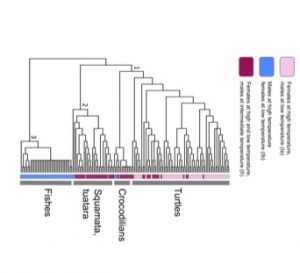
About the Author: Dr. Bonnie Derne (@b_derne) recently completed a PhD within the Lab of Evolutionary Genetics and Sociality at Flinders University, South Australia. She used genetic markers to track parasite dynamics during the experimental translocation of an endangered skink, and is generally interested by parasite ecology, conservation biology and the ways in which molecular tools can be used to answer questions in these fields.
The sex ratio of a wild population can be a determinant of its persistence over time and space, particularly in the context of climate change and the other anthropogenic pressures placed on our ecosystems. Skewed sex ratios can result in mate shortages, increased inter-sexual conflict and reduced parental care for offspring. Evolutionary consequences can include reduced effective population size, weakening of sexual selection, and lowered adaptive potential. Potential effects of unequal sex ratios also extend to the broader ecosystem when different sexes of a species are not ecologically equivalent, for example when each sex partakes in different trophic interactions, or when each sex plays a different role in processes such as nutrient cycling.
If balanced sex ratios are required for wild populations to be more resilient to rapid environmental change, of major concern is that warming associated with climate change can in turn exert a direct influence on sex ratio. One mechanism by which this may happen is the differential survival of the respective sexes if one sex in a species is more heat tolerant than the other. Alternatively, rising temperatures have noticeably skewed sex ratios in some species exhibiting temperature-dependent sex determination (TSD), commonly exemplified by the feminization of sea turtle populations (up to 99% in some populations) as average temperatures creep upwards. In contrast to cases where sex is solely temperature-determined, some species can undergo sex reversal. In these systems, temperature-dependent sex determination can occur later in development, where it phenotypically overrides genetic sex determination (GSD), as observed in some fish species.

Noticing the dearth of animal and plant studies that measured sex-specific heat tolerance, Professor Suzanne Edmands from the University of Southern California assessed the current level of understanding of how rising temperatures are and may affect sex ratios across taxa in her recent review (Edmands 2021). Accordingly, she found that less than 10% of almost 200 identified heat tolerance studies spanning plant, animal and protozoan taxa reported results by sex. Some of these studies focused on immature stages that may have been impractical to sex, or offered explanations for lack of sex-specific result reporting, but more than half did not address the issue of sex at all. This trend appears to echo historic biases for only including males in medical studies, with the assumption that females were physiologically analogous. This widespread lack of knowledge of sex-specific heat tolerance hampers our ability to predict how species are being, and will continue to be, affected by climate change. Furthermore, sex-biased thermal tolerance can either increase or counteract the sex-ratio bias caused by temperature-dependent sex determination and sex reversal – there is therefore a need to understand which of these scenarios play out in different species that exhibit this trait.
In this review, Edmands (2021) takes a preliminary step towards resolving this important knowledge gap by also examining the phylogenetic distribution of species known to exhibit sex-specific heat tolerance. Arthropod studies most commonly reported heat tolerance by sex, though examples were found across other chordate taxa, as well as in plants and protozoans. For studies that reported a sex-based difference between heat tolerance, a higher female tolerance was more common, though this was variable between and within taxa, no doubt due to the large number of morphological, physiological and life-history factors that can contribute to heat tolerance. Conclusive documentation of TSD was restricted to reptiles, where it appears to have evolved several times, and also fish. For TSD reptiles, high temperatures usually make for female-heavy sex ratios, while the converse appears to be universally true for fish species known to exhibit TSD (Figure 1). Temperature-dependent sex reversal also tends to produce male biases across fish taxa, as well as in amphibians. In contrast, temperature dependent sex reversal produces a more equal proportion of high-temperature feminization and masculinization in reptile species. The review also considers a diverse range of possible demographic consequences as various temperature sensitivities interact with different sex-determination systems. These consequences include the loss of sex chromosomes Y and W chromosomes from populations with XX/XY and ZZ/ZW sex chromosome systems respectively, or alternatively their maintenance over evolutionary time.
This work highlights the taxonomic breadth of temperature-sensitive sex ratios and the fact that among species affected temperature-induced masculinization is common, which is predicted to generally pose the most significant threat to population viability. Among the growing number of observed temperature-disrupted sex ratios is evidence that organisms can adapt, behaviorally or otherwise, to redress these sex ratio imbalances. However, these changes seem unlikely to be sufficient to mitigate the effects of such rapid climate change. The salient point here is that we have so much more to learn about the taxonomic extent and species-specific consequences of temperature driven sex-ratios. Such knowledge is crucial if we are to devise effective conservation management plans for these species and ecosystems.
References



